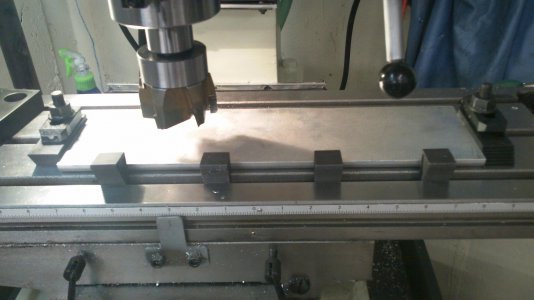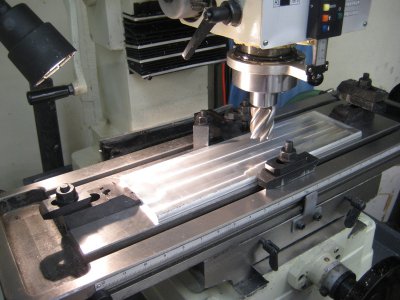- Joined
- Jun 23, 2011
- Messages
- 786
I need to face 1/2" flat plate to make some 10 mm stock for a small model engine (Jan Ridder's Otto). I'd like to be able to clamp it once and do all of the milling without repositioning clamps (as it inevitably changes the height a tiny bit and ruins the flatness - tried it and have the T-shirt!) to complete the operation. The plate is about 18" long by 5" wide.
I have a clamping set (two actually). So far I've stacked two straps on each side of the plate and tapped them in tight. 4 step blocks are inserted into the table slots, narrow end first, creating a 90 degree fixed jaw of sorts along the front of the plate. If I could figure a way to make a quick and dirty moveable jaw on the back edge of the plate that I could use to push the plate against the step blocks, I think I'd have it. Any suggestions?
Take a look at the photo if it's not clear what I'm trying to explain...
Is there a cool trick to do this sort of thing as far as clamping goes using HSM type stuff? If it was lowly wood I'd just pass it thru my planer...
Thanks!
John

I have a clamping set (two actually). So far I've stacked two straps on each side of the plate and tapped them in tight. 4 step blocks are inserted into the table slots, narrow end first, creating a 90 degree fixed jaw of sorts along the front of the plate. If I could figure a way to make a quick and dirty moveable jaw on the back edge of the plate that I could use to push the plate against the step blocks, I think I'd have it. Any suggestions?
Take a look at the photo if it's not clear what I'm trying to explain...
Is there a cool trick to do this sort of thing as far as clamping goes using HSM type stuff? If it was lowly wood I'd just pass it thru my planer...
Thanks!
John

Last edited by a moderator:


